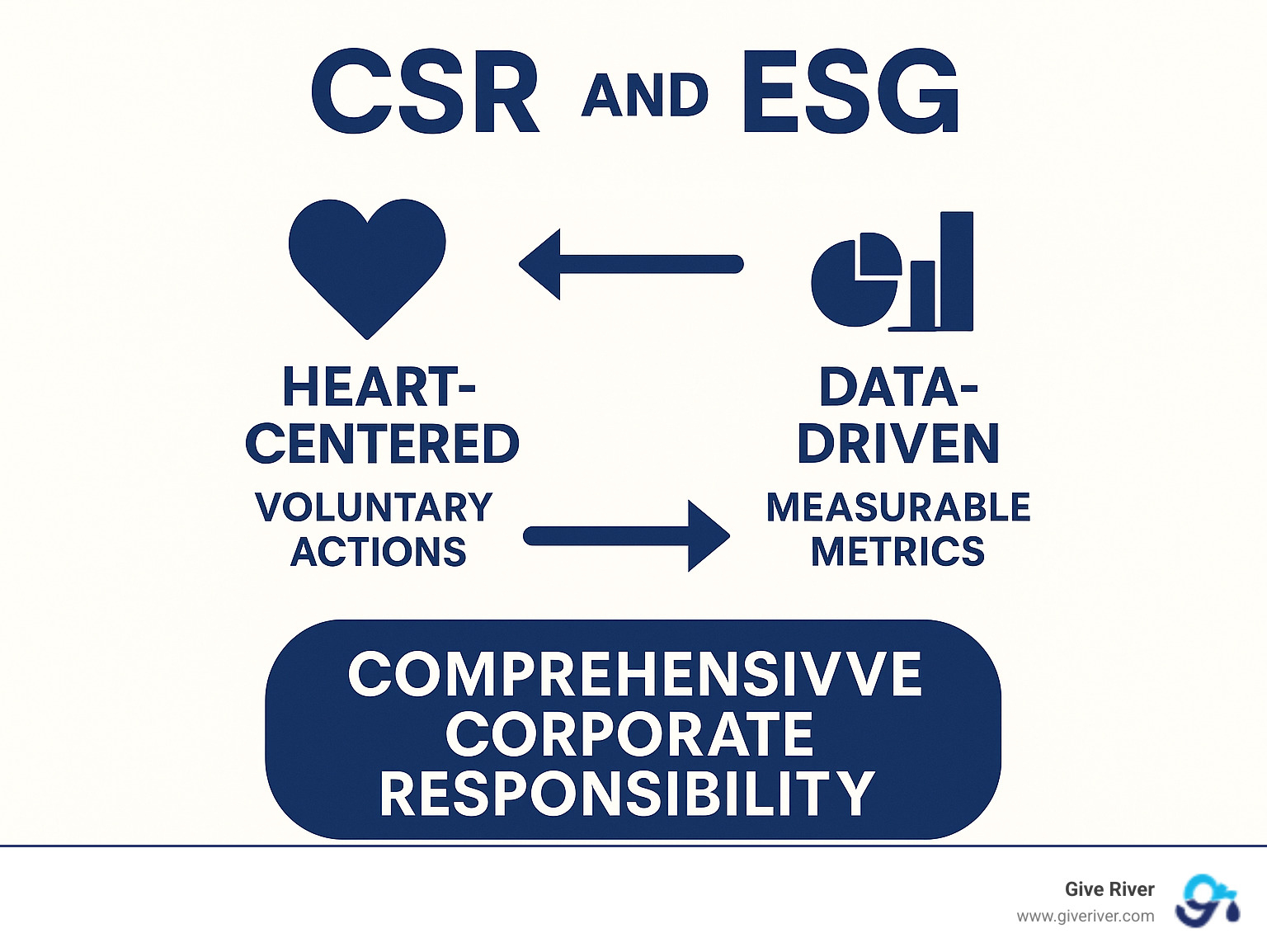Navigating the Landscape: CSR and ESG Initiatives Demystified
Navigate the landscape of csr and esg initiatives. Discover their core differences, why both are crucial, and how to put principles into practice.

From Corporate Buzzwords to Business Imperatives
CSR and ESG initiatives have evolved from nice-to-have add-ons to critical business imperatives impacting your bottom line, talent retention, and market competitiveness. While these acronyms seem like corporate "alphabet soup," understanding their distinct roles is key to improving your workplace culture and employee engagement.
Quick comparison for busy executives:
- CSR (Corporate Social Responsibility): Voluntary actions focused on doing good—think charitable giving, community volunteering, and ethical business practices
- ESG (Environmental, Social, Governance): Data-driven framework measuring sustainability and ethical impact—tracked through specific metrics that investors and regulators increasingly demand
- Key difference: CSR asks "How can we help?" while ESG asks "How do we measure and prove our impact?"
The stakes have never been higher. Research shows that 71% of consumers are actively changing their lifestyles to be more sustainable, while 66% consider sustainability a key factor in their purchasing decisions. Even more compelling for HR leaders: 59.7% of employees say they'd be more loyal to companies with strong CSR initiatives—if they actually know about them.
Many organizations stumble by treating CSR and ESG as separate, rather than complementary, strategies. While employee recognition platforms like Bonusly or Kudos excel at internal engagement, they often miss the opportunity to connect that engagement with external community impact. The most successful companies integrate both, using platforms like Give River to create an authentic culture of purpose that resonates with employees, customers, and investors.
As Meghan Calhoun, I've witnessed how purpose-driven workplace initiatives can transform team dynamics and employee fulfillment. Through my experience building employee experience platforms, I've seen how CSR and ESG initiatives become powerful tools for creating the healthier, more meaningful workplaces that today's workforce demands.

Handy csr and esg initiatives terms:
The Core Differences: Unpacking CSR and ESG Initiatives
While CSR and ESG initiatives are often used interchangeably, understanding their distinct roles is crucial for building a purpose-driven workplace that moves the needle on employee engagement and business performance. Think of it this way: if your company were a person, CSR would be its heart—the values-driven desire to do good—while ESG would be its report card, measuring and proving that good actually happened.
What is CSR? The Foundation of Corporate Conscience
Corporate Social Responsibility (CSR) is a company's commitment to operating ethically and contributing to sustainable development by improving the quality of life for employees, communities, and society. It's the "we should do this because it's right" approach.
CSR's roots trace back to the 1950s and Howard Bowen's Social Responsibilities of the Businessman, which questioned businesses' obligations to society. This laid the groundwork for integrating social and environmental concerns into business strategy. What makes CSR special is its voluntary nature; these actions go beyond legal requirements and are driven by internal values. The focus is often qualitative, telling meaningful stories about impact.
Stakeholder theory, championed by Robert Edward Freeman, broadened this focus to include employees, customers, and communities, not just shareholders, laying the foundation for more holistic business practices. Unlike employee engagement platforms like Bonusly or Kudos that focus primarily on internal recognition, CSR initiatives—and the platforms like Give River that power them—create an external community impact that can significantly boost employee pride and retention.
To dive deeper into CSR fundamentals, explore What is CSR?, What is the Purpose of Corporate Social Responsibility?, and Examples of Corporate Social Responsibility.
What is ESG? The Data-Driven Evolution
If CSR is the heart, Environmental, Social, and Governance (ESG) is the data-driven brain. ESG provides a framework for investors and stakeholders to assess a company's sustainability and ethical performance using concrete metrics.
The term 'ESG' gained a clear definition in a 2004 UN report, shifting the conversation from values-based discourse (doing good because it's right) to value-based discourse (doing good because it creates financial value). While its application can be ambiguous, as highlighted in the Financial Times documentary "Who Killed the ESG Party?", its core purpose is to provide measurable criteria for sustainability assessment. Research consistently shows that ESG performance correlates positively with corporate financial performance.
ESG operates through three core pillars: Environmental (E) (e.g., Microsoft's carbon-negative goal), Social (S) (e.g., Verizon's digital inclusion initiatives), and Governance (G) (e.g., leadership accountability and ethical practices). Unlike CSR's self-regulated nature, ESG faces increasing regulatory pressure. For example, the EU's Corporate Sustainability Reporting Directive (CSRD) mandates reporting with significant penalties for non-compliance, making ESG nearly mandatory for many international businesses.
CSR vs. ESG: A Head-to-Head Comparison
While both foster responsibility, their core difference is purpose. CSR is the "why"—a philosophical commitment to doing good. ESG is the "how"—a measurable framework for proving it.
| Feature | Corporate Social Responsibility (CSR) | Environmental, Social, and Governance (ESG) |
|---|---|---|
| Purpose | Doing good, building reputation, aligning with internal values | Assessing material risks & opportunities, attracting investment, driving value |
| Reporting | Often qualitative, narrative-driven, output-based | Quantitative, data-driven, outcome-based, standardized metrics |
| Drivers | Internal values, ethical considerations, brand management | Investor demand, regulatory compliance, risk management, financial performance |
| Scope | Broad initiatives, often external-facing (e.g., philanthropy) | Specific, measurable criteria across E, S, G pillars, often internal processes |
CSR and ESG are complementary, not competing. CSR activities, like employee volunteering, generate data for ESG reports. CSR builds awareness, while ESG provides the hard data that builds investor confidence. Companies that effectively integrate both often find themselves with stronger, more resilient business models.
For deeper insights into tracking and communication, review What is Corporate Social Responsibility Reporting?.
Why Both CSR and ESG Initiatives Matter Now More Than Ever

The business landscape has fundamentally shifted. Consumer demand, investor expectations, regulatory pressure, and the war for talent have converged, making CSR and ESG initiatives essential for growth. Investors now use ESG criteria to evaluate risk and opportunity, linking sustainability to financial performance. At the same time, regulations like the EU's CSRD are making ESG reporting mandatory, with severe penalties for non-compliance.
Today's workforce seeks purpose-driven employers, making strong CSR and ESG programs critical for attracting and retaining top talent. In an age of instant information, these strategies are also vital for building trust, enhancing brand value, and managing reputational risk before crises emerge. Neglecting CSR and ESG initiatives is no longer a viable option for long-term success.
For deeper exploration of these motivations, visit Purpose Driven Workplace and What are the five driving forces of corporate social responsibility.
Putting Principles into Practice: Implementing and Communicating Your Strategy
Understanding CSR and ESG initiatives is one thing; implementing them is another. Effective implementation isn't about perfection—it's about taking authentic, measurable steps that align with your company's values and stakeholder expectations.
Best Practices for Implementing CSR and ESG Initiatives

Successful CSR and ESG initiatives begin with a materiality assessment to identify what matters most to your business and stakeholders. This roadmap focuses your resources on areas of meaningful impact.
Next, set SMART goals. Move beyond vague commitments to specific targets like "reduce landfill waste by 20% by 2025." This provides clear, measurable objectives.
Don't treat sustainability as a side project. Integrate initiatives into your corporate culture by embedding them in daily operations. Unlike platforms like Bonusly or Kudos that focus on internal recognition, Give River's 5G Method connects employee fulfillment directly with community impact, making these efforts personal and engaging.
Engage employees through volunteering. Offering paid time off for volunteering or organizing service days builds authentic team connections and fosters pride in the company.
Avoid greenwashing with brutal honesty. Be transparent about progress and challenges. Stakeholders value authenticity over perfection and will respect your transparency.
Finally, secure leadership buy-in. When executives actively participate and allocate resources, it signals that these initiatives are a core priority, ensuring they gain traction.
For deeper insights into building these programs, explore:
Building Trust: How to Measure, Report, and Communicate Your Impact

Once your CSR and ESG initiatives are underway, the real work begins: proving your impact through transparent, consistent communication.
Measure performance with robust data collection. For ESG, this means tracking quantitative metrics like greenhouse gas emissions (Environmental), employee diversity rates (Social), and board independence (Governance). Investing in data management systems is key to credibility.
Use standardized reporting frameworks like the Global Reporting Initiative (GRI) or Sustainability Accounting Standards Board (SASB) to make your data comparable and credible. These frameworks ensure your reporting meets investor and regulator expectations.
Build trust through transparency. Acknowledge challenges alongside successes. This authentic approach protects against accusations of greenwashing and builds credibility far more effectively than polished marketing.
Tailor communication to your stakeholders. Investors need financial data, employees want to see community impact, and customers care about ethical practices. Use multiple channels to deliver relevant information to each group.
The benefits of strong reporting extend beyond compliance, leading to improved brand value, stronger financial performance, better talent attraction and retention, and improved risk management. A purpose-driven workplace that can prove its impact becomes a magnet for customers, investors, and top talent.
Modern technology can streamline this entire process. Platforms like Give River help organizations track and amplify their positive impact by connecting employee engagement with meaningful community involvement. Through our tools, companies can seamlessly manage charitable giving at work, track volunteer hours, and quantify their social contributions—all feeding directly into robust ESG reporting.
Ready to transform your workplace culture through measurable impact? Explore these resources:




